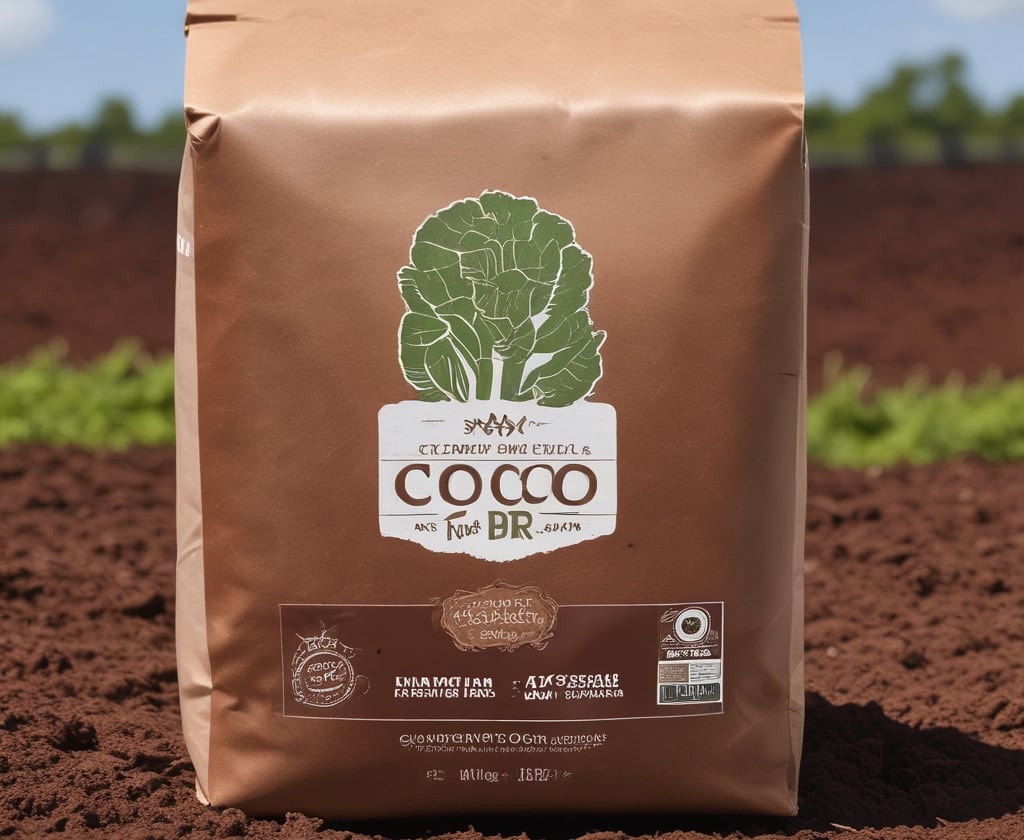What is Cocopeat? Benefits & Uses for Gardening
Discover what cocopeat is, its numerous benefits, and how to effectively use it for plants. Learn the best practices for incorporating cocopeat into your gardening routine for optimal growth.
10/16/20257 min read


Introduction to Cocopeat
Cocopeat, also known as coir pith or coir fiber pith, is a natural byproduct derived from the processing of coconut husks. The process begins with the harvesting of coconuts, where the tough outer husks are separated from the fruit. These husks are then subjected to a method of retting, typically involving water, which helps in loosening the coir fibers from the pith. Once separated, the silky fibers can be utilized in various industries, while the remaining pith, which is lightweight and spongy, is processed into cocopeat.
The origins of cocopeat can be traced back to regions where coconuts are abundantly grown, such as tropical climates in Asia, Africa, and the Caribbean. Given its abundance as a byproduct of the coconut industry, cocopeat is not only an eco-friendly material but also contributes to sustainable agricultural practices. The production of cocopeat involves minimal environmental disruption, promoting the concept of waste minimization by utilizing materials that would otherwise be discarded.
Cocopeat is increasingly recognized for its remarkable properties that offer numerous benefits for gardening and farming. It possesses excellent water retention capabilities, allowing it to support plant hydration and vitality. Furthermore, cocopeat is naturally rich in nutrients and acts as a sustainable soil amendment, enhancing soil structure and aeration. Its compostable nature makes it an attractive alternative to peat moss, which is being depleted in various ecosystems. The environmental implications of cocopeat use underscore its value in promoting sustainability within the horticultural and agricultural sectors, making it a vital component in the shift towards greener practices.
Benefits of Cocopeat for Plants
Cocopeat, derived from the fibrous husk of coconuts, has garnered significant attention in the gardening and agricultural sectors due to its multifaceted benefits. One of the primary advantages of cocopeat is its remarkable moisture retention capacity. This organic material can absorb and hold water up to eight times its weight, ensuring that plants have a steady supply of moisture, especially during dry periods. This trait is particularly beneficial for growers in regions with erratic rainfall, as it reduces the frequency of irrigation and conserves water resources.
Moreover, cocopeat significantly improves soil aeration. The fibrous structure of cocopeat creates a porous environment, allowing for better air circulation within the soil. Enhanced aeration supports healthy root systems by supplying essential oxygen, which is critical for root respiration and overall plant vitality. Well-aerated soil also aids in preventing waterlogging, which can lead to root rot and other diseases.
Another important aspect of cocopeat is its ability to offer essential nutrients to plants. While it does not contain all nutrients, cocopeat is often enriched with fertilizers or mixed with other soil amendments to create a balanced growing medium. This synergistic mix can lead to enhanced plant growth and development, as the nutrients become more accessible for uptake by plant roots.
Importantly, cocopeat is an eco-friendly option in the gardening industry. Being a renewable resource, it contributes to sustainable practices by reducing reliance on non-biodegradable materials. Additionally, cocopeat helps in waste reduction by repurposing coconut husks that would otherwise contribute to landfill accumulation. As such, its use in gardening promotes not only healthier plants but also a more sustainable relationship with our environment.
Common Uses of Cocopeat
Cocopeat, a natural byproduct of coconut husks, has emerged as a versatile and valuable material in both gardening and agricultural practices. One of its most common applications is in potting mixes, wherein it serves as a crucial component for growing plants. Due to its excellent water retention properties, cocopeat helps maintain adequate moisture levels within the potting medium, ensuring that plants receive the necessary hydration without the risk of waterlogging. This characteristic is particularly beneficial for those who may have a tendency to underwater or overwater their potted plants.
Another prominent use of cocopeat is in seed starting. This material provides an ideal growth environment for seedlings, as it is light, sterile, and free from harmful pathogens. When used in seed flats or trays, cocopeat creates a perfect medium that encourages healthy germination and root development, giving seedlings the best possible start. Additionally, when blended with other materials, such as vermiculite or perlite, cocopeat facilitates improved drainage and aeration, further enhancing the conditions required for seedling growth.
Furthermore, cocopeat functions as an effective soil amendment. By mixing it into the garden beds, gardeners can improve soil structure, enhance aeration, and significantly boost water retention capabilities. This not only benefits the existing plants but also encourages beneficial microbial activity in the soil. The versatility of cocopeat extends beyond indoor horticulture, as it has proven effective in outdoor gardening and farming practices, ranging from raised beds to hydroponic systems. Its natural origins and eco-friendly properties make it an appealing choice for environmentally conscious growers looking to enhance their gardening experience.
How to Prepare Cocopeat for Use
Preparing cocopeat for use in gardening involves several simple yet essential steps that ensure it is ready to support plant growth effectively. First and foremost, obtain high-quality compressed cocopeat blocks, which are often sold in various sizes. These blocks are relatively lightweight but can expand significantly when rehydrated, providing an excellent growing medium.
To begin, place the compressed cocopeat block in a large container or bucket. Add warm water gradually over the block, allowing it to soak up the moisture. It's important to use warm water as it aids in faster rehydration. Typically, a ratio of about 5 to 6 liters of water for a standard block is recommended. Allow the cocopeat to absorb the water for approximately 30 minutes. During this time, you may notice the cocopeat breaking apart and expanding in volume.
Once rehydrated, you should fluff up the cocopeat to achieve a light and aerated texture, essential for optimal root growth. This can be done easily using your hands or a garden fork. It is advisable to wear gloves for hygiene and protection reasons. If desired, you can mix the cocopeat with other growing mediums such as perlite, vermiculite, or garden soil to enhance drainage and aeration further while retaining moisture. The typical mix could involve equal parts of cocopeat and these additives, although adjustments can be made based on specific plant needs.
For those who prefer to use cocopeat alone, it can also serve well as a standalone growing medium. Ensure proper drainage by using pots with holes at the base, allowing excess water to escape and preventing root rot. Moreover, it's beneficial to periodically check moisture levels, as cocopeat retains water well. With these steps, you can prepare cocopeat to create optimal conditions for your plants and encourage healthy growth.
Comparison with Other Growing Media
Cocopeat, derived from the husk of coconuts, has gained popularity as a growing medium for various horticultural applications. When compared to other common growing media such as peat moss, perlite, and vermiculite, cocopeat offers several distinct characteristics that merit consideration.
Peat moss, often used for its moisture retention properties, is favored for its ability to support plant growth. However, its extraction raises environmental concerns due to habitat destruction. In contrast, cocopeat is a renewable resource, making it more eco-friendly. It retains moisture effectively while also providing aeration, contributing to a balanced environment for root development. This dual capability makes cocopeat a strong contender against peat moss.
Perlite, a volcanic glass, is often employed to enhance aeration in growing mediums. While it is lightweight and promotes drainage, it lacks organic matter and moisture retention capabilities. Cocopeat, on the other hand, strikes a balance between aeration and moisture retention. This makes cocopeat not only beneficial for seed germination but also for maintaining healthy plant growth over time.
Vermiculite, another growing medium, is known for its excellent moisture-holding capacity and ability to improve soil structure. While it provides some benefits similar to those of cocopeat, it is often more expensive and less sustainable. Cocopeat presents an economically viable alternative that is widely accessible and effective.
In terms of user-friendliness, cocopeat can be easily mixed with other media, making it versatile for various gardening needs. Its neutral pH and low salt content further enhance its appeal for different plant species. Overall, while each growing medium has its advantages and disadvantages, cocopeat emerges as a multifaceted option for gardeners looking for sustainable, effective, and eco-friendly solutions.
Tips for Using Cocopeat Effectively
To maximize the effectiveness of cocopeat in your gardening practices, it is essential to adopt a strategic approach that takes into account various factors, including blending ratios, watering frequency, and pH monitoring. First and foremost, consider the right blending ratios of cocopeat with other growing mediums such as soil or perlite. A common recommendation is to mix cocopeat with one part perlite and two parts soil. This combination enhances drainage while providing necessary moisture retention, ensuring robust plant growth.
Watering frequency is another critical consideration when using cocopeat. Due to its high water retention capacity, cocopeat may not require frequent watering compared to traditional soil. It is advisable to check the moisture level of the medium before watering, ensuring that the plants do not suffer from overwatering, which can lead to root rotting. Typically, allowing the top inch or so of the cocopeat to dry out before the next watering helps maintain optimal moisture balance.
Furthermore, monitoring the pH level of cocopeat is vital for the health of your plants. Cocopeat tends to have a neutral pH, generally ranging from 5.5 to 6.5, which is suitable for most plants. However, it is invaluable to regularly test the pH using a reliable soil testing kit. If the pH leans too acidic or alkaline, consider adjusting it by blending other materials as required.
Lastly, cocopeat is an organic product that may contain salts from the processing stage. Rinsing it thoroughly before use can help remove excess salts, thereby preventing potential nutrient imbalances in your plants. By implementing these practical tips, gardeners can effectively harness the benefits of cocopeat, promoting healthy growth and bountiful yields.
Conclusion: Embracing Cocopeat in Gardening
In recent years, cocopeat has emerged as a significant material in sustainable gardening and agriculture. This versatile growing medium, derived from coconut husks, is lauded for its ability to retain moisture while providing excellent aeration to plant roots. As a result, incorporating cocopeat into gardening practices offers numerous advantages, including improved plant health and enhanced soil structure.
The benefits of using cocopeat are multi-faceted. Not only does it help in moisture retention, which is vital for maintaining optimal plant growth, but it also improves soil fertility by aiding nutrient absorption. Its lightweight nature makes it ideal for potting mixes, allowing for easier handling and transportation. Furthermore, cocopeat acts as an environmental boon, as it is a renewable resource that minimizes waste associated with coconuts, promoting a more sustainable gardening approach.
The diverse uses of cocopeat extend beyond typical gardening practices. It can be utilized in home gardens, greenhouses, or even large-scale agricultural settings. When mixed with other soil amendments, cocopeat enhances soil quality, making it suitable for a wide range of plants. Best practices suggest combining cocopeat with organic fertilizers to provide nutrients, thereby maximizing its potential. This combination fosters healthier plants and improves yields, creating a win-win situation for gardeners and farmers alike.
As we move towards more sustainable practices in horticulture, it is essential for gardeners to consider embracing cocopeat as a primary component of their gardening mixes. Whether you are a novice gardener or an experienced horticulturist, incorporating cocopeat can lead to healthier plants, improved soil conditions, and a more sustainable approach to gardening. It is time to take action and elevate your gardening practices by adopting this innovative, eco-friendly growing medium.
Pure Coco
Explore our range of coco peat products today.
Support
Contact
info@purecoco.com
+91-9015762289
© 2025. All rights reserved.
Support
